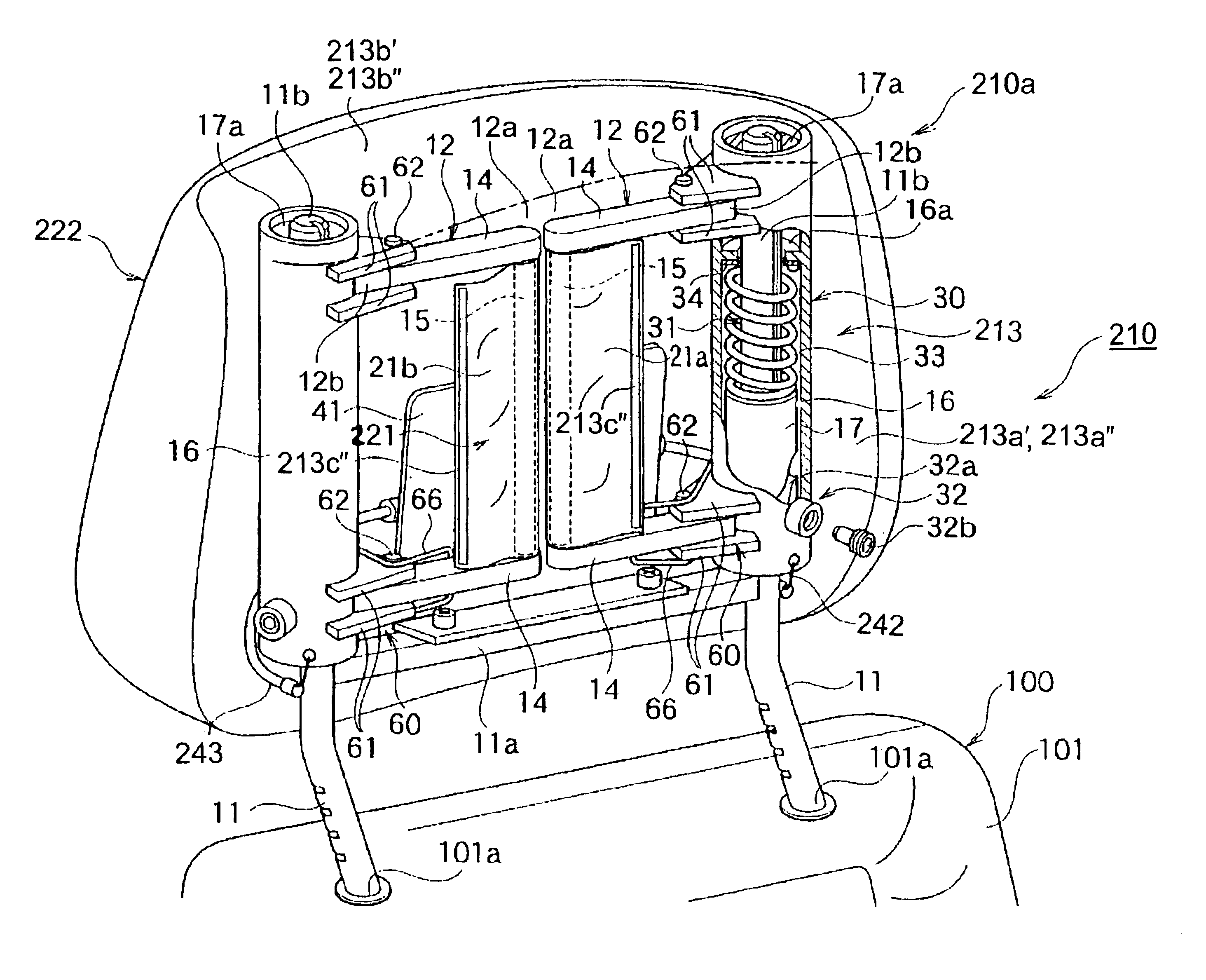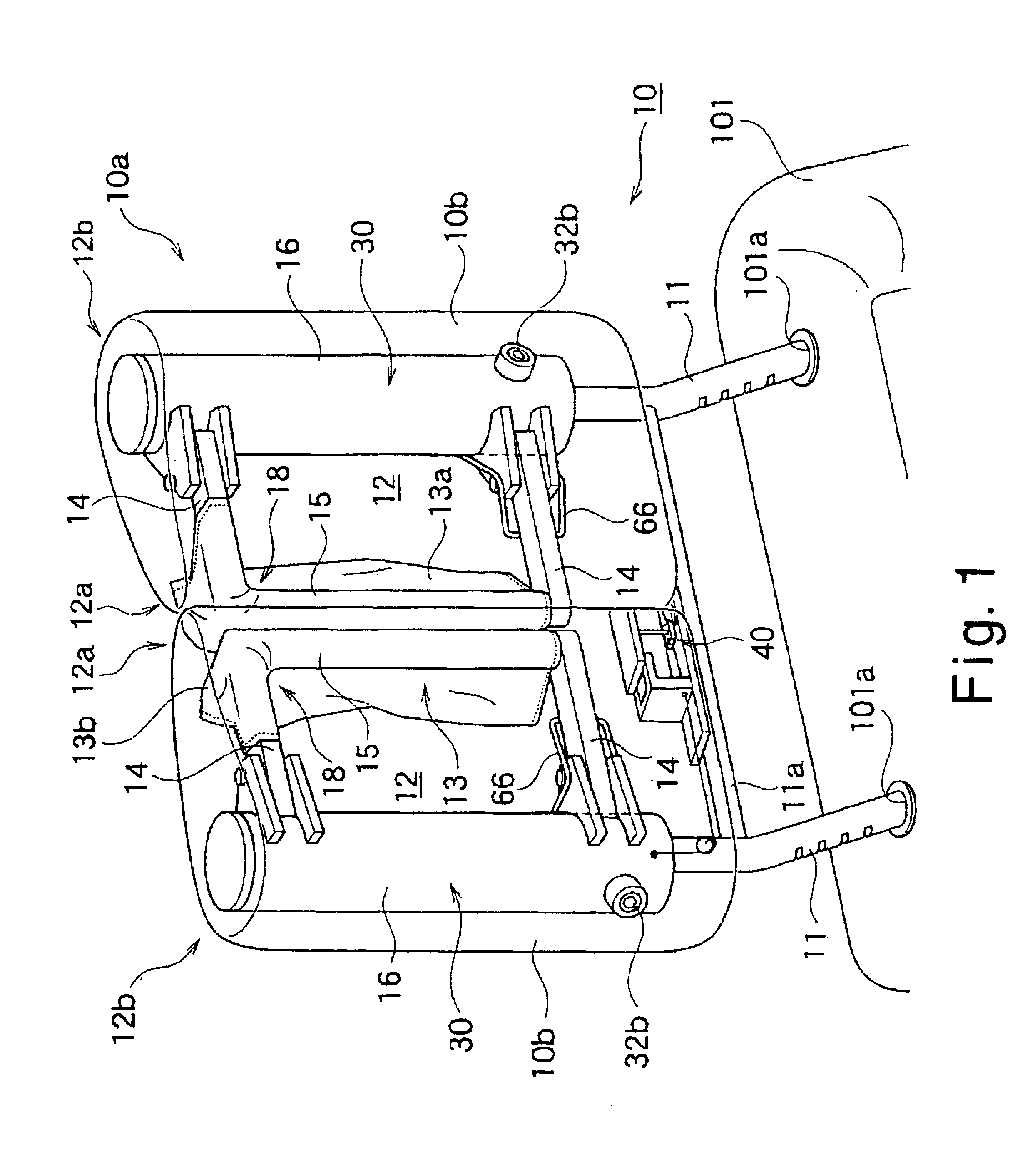Vehicle headrest apparatus
a headrest and vehicle technology, applied in the direction of vehicular safety arrangements, chairs, pedestrian/occupant safety arrangements, etc., can solve the problems of reducing the protective effect of airbags, imposing a severe stress on the ears of passengers, and the headrest units cannot be moved sufficiently forward, so as to reduce the headrest restraining effect
- Summary
- Abstract
- Description
- Claims
- Application Information
AI Technical Summary
Benefits of technology
Problems solved by technology
Method used
Image
Examples
first embodiment
[0074]Referring initially to FIGS. 1 to 18, the vehicle headrest apparatus 10 is illustrated in accordance with a first embodiment of the present invention. FIG. 1 is a front perspective view of the headrest unit in an initial state. FIG. 2 is an overall perspective view of a seat installed with the headrest unit. FIG. 3 is an enlarged perspective view of the headrest unit depicting a main component in a cross-sectional manner. As shown in FIGS. 1 to 3, the vehicle headrest apparatus 10 of this embodiment includes a headrest unit 10a with a mounting member comprising a pair of stays 11. The vehicle headrest apparatus 10 is adjustably coupled to a vehicle seat 100 by the stays 11. More specifically, the vehicle headrest apparatus 10 is attached to the upper end part of a seatback 101 of the vehicle seat 100. Thus, the headrest unit 10a is arranged to support the head of a seated passenger sitting in the vehicle seat 100. The stays 11 of the headrest unit 10a are mounted in a pair of ...
second embodiment
[0140]Referring now to FIGS. 19 to 21, a vehicle headrest apparatus 10′ in accordance with a second embodiment will now be explained. Basically, the headrest apparatus 10′ is identical to the headrest apparatus 10, as discussed above, except that a modified flexible sheet restraining member 13′ is used instead of the sheet member 13 of the first embodiment. In view of the similarity between the first and second embodiments, the parts of the second embodiment that are identical to the parts of the first embodiment will be given the same reference numerals or symbols as the parts of the first embodiment. Moreover, the descriptions of the parts of the second embodiment that are identical to the parts of the first embodiment may be omitted for the sake of brevity.
[0141]FIG. 19 is a perspective view of the headrest apparatus 10′ in the completely deployed state with the cushion pad removed. FIG. 20 is a rear perspective view of the headrest apparatus 10′ in the completely deployed state....
third embodiment
[0148]Referring now to FIGS. 22 to 24, a vehicle headrest apparatus 10″ in accordance with a third embodiment will now be explained. Basically, the headrest apparatus 10″ is identical to the headrest apparatus 10, as discussed above, except that a modified flexible sheet restraining member 13″ is used instead of the sheet member 13 of the first embodiment. In view of the similarity between the third embodiment and the prior embodiments, the parts of the third embodiment that are identical to the parts of the prior embodiments will be given the same reference numerals or symbols as the parts of the prior embodiments. Moreover, the descriptions of the parts of the third embodiment that are identical to the parts of the prior embodiments have been omitted for the sake of brevity.
[0149]FIG. 22 is an enlarged cross-sectional perspective view of the main components of the headrest apparatus 10″. FIG. 23 is a rear perspective view of the headrest apparatus 10″ in the completely deployed st...
PUM
 Login to View More
Login to View More Abstract
Description
Claims
Application Information
 Login to View More
Login to View More - R&D
- Intellectual Property
- Life Sciences
- Materials
- Tech Scout
- Unparalleled Data Quality
- Higher Quality Content
- 60% Fewer Hallucinations
Browse by: Latest US Patents, China's latest patents, Technical Efficacy Thesaurus, Application Domain, Technology Topic, Popular Technical Reports.
© 2025 PatSnap. All rights reserved.Legal|Privacy policy|Modern Slavery Act Transparency Statement|Sitemap|About US| Contact US: help@patsnap.com



